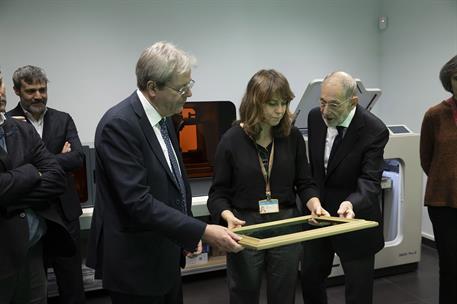Digitization work for the virtual visit to the National Museum of Roman Art, in Mérida (Badajoz)
The Ministry of Culture is extending online access to and dissemination of the sixteen state museums it manages directly in different parts of Spain. From now on, they will be offering new high-resolution virtual tours, a project within the framework of the Recovery, Transformation and Resilience Plan. A total of €478,880 of European funds have been invested in this project.
The new virtual tours, developed with Second Canvas technology, enable free visits to the museum collections and allow visitors to explore the rooms with super-zoom, as well as access new content in different formats such as explanatory videos on the meaning and historical context of the pieces, audio documents or scientific or informative publications. In addition, 200 pieces have been selected which can be explored in detail thanks to high-resolution images, and which are accompanied by short stories created by the curators to reveal their secrets.
The National Museum of Underwater Archaeology ARQVA, in Cartagena (Murcia); the National Archaeological Museum, the Costume Museum. Centre for Research into Ethnological Heritage, Museo Sorolla, Museo Cerralbo, The National Museum of Decorative Arts, National Museum of Romanticism, Museum of the Americas and the National Museum of Anthropology, in Madrid; National Museum of Roman Art, in Mérida (Badajoz); National Museum and Research Centre of Altamira, in Santillana del Mar (Cantabria); Museo del Greco and The Sephardic Museum, in Toledo; 'González Martí' National Museum of Ceramics and Decorative Arts, in Valencia; National Museum of Sculpture and Cervantes House-Museum, in Valladolid; are the 16 state museums directly managed by the Ministry of Culture that will now have this new way of being visited.
Virtual tours and information in different formats
In all 16 museums, 1,623 panoramic views of the rooms and spaces have been digitised. For example, the National Archaeological Museum displays more than 400 panoramas, and the National Museum of Roman Art has more than 200. Each super-high-resolution image of a panorama is, in turn, obtained by subsequently taking and combining dozens of high-resolution photographs of each room. In total, more than 46,000 high-resolution photographs of the rooms have been taken.
The virtual tours are completed with 310 points of interest that allow access to information in different formats such as videos or audios related to the pieces and spaces of the museum. Each virtual tour also includes a 'Welcome Tour', a spoken and subtitled introduction that takes the virtual visitor through the rooms, putting them in context before the free visit.
Unnoticed details and short stories
The super high-resolution images allow visitors to get up close to the pieces in a way that is not possible in an on-site visit and with the naked eye. The digitisation was carried out with MadpixelROB, a robotised and computerised capture system with shooting assistance systems, which made it possible to capture images with Ultra HD resolution (245 megapixel) and gigapixel resolution (1,000 megapixel) of the pieces in the rooms where they are exhibited, without the need to take them down or move them.
The flexibility of this system has also made it possible to adapt to the different formats of the pieces and to digitise paintings, mosaics, textiles, furniture, carvings, plasterwork and archaeological remains of different sizes, from 30 centimetres to pieces of several metres, such as large paintings, murals, façades or large ceilings.
For example, in the Sephardic Museum in Toledo, the smallest piece digitised was a Bar Kojba coin, barely 20 millimetres in diameter, while the largest was the East Wall of the Synagogue of El Tránsito, measuring 9.5 x 16 metres.
In addition, some pieces have also been photographed with infrared gigapixel technology that allows details such as repainting or small irregularities in the canvas to be appreciated, as in the case of 'El Salvador' in the Museo del Greco, in Toledo; 'Satire of Romantic Suicide' by Leonardo Alenza in the Museum of Romanticism, in Madrid; and the 'Self-portrait' by Joaquín Sorolla on display in the Museo Sorolla, in Madrid.
Non official translation






